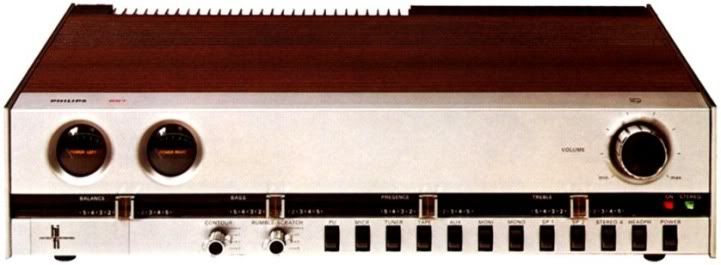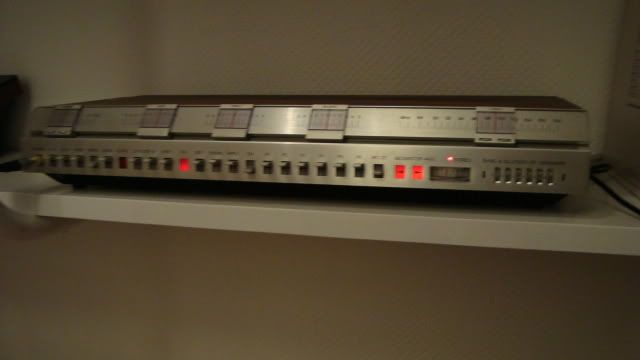You are using an out of date browser. It may not display this or other websites correctly.
You should upgrade or use an alternative browser.
You should upgrade or use an alternative browser.
Vintage amp rated at 40w @ 4ohms?
- Thread starter chunky007
- Start date
mhardy6647
Lunatic Member
Nope, but the output power into 8 ohms could be as little as half of the 4 ohm power output. Partly a numbers game, and it will depend on the current capability of the amplifier (I am assuming it is solid state - I don't know the model no. off the top of my head - and either direct or cap coupled)... but it should be quite happy driving an 8 ohm load.
Glen B
Super Member
Looking at an old Phillips 521 amp & noticed it's rated at 40w @ 4ohms. Wondered if there was any need for concern running 8ohm speakers, thanks in advance.
You must mean Philips Model RH521. Its rated 8 ohm output is 30W.
Is it this one ?

Last edited:
mhardy6647
Lunatic Member
You must mean Philips Model RH521. Its rated 8 ohm output is 30W.
Is it this one ?

I think so; there you go, then. 30 wpc @ 8 ohms.
mhardy6647
Lunatic Member
...or there's a typo on the rear apron. An amp rated for 40 watts at 4 ohms might quite reasonably expected to deliver 30 watts into 8 ohms.
I'd assume that it's in the neighborhood of 20 to 30 wpc into 8 ohms and plan accordingly. Remember that the difference between 20 watts and 40 watts is only 3 dB.
Given the amp's cosmetics, it may date to the later part of the short-lived "quad" era, though... so the OP's interpretation of the rear apron power spec labeling could well be correct.
It's not a familiar amp to US eyes (FWIW).
I'd assume that it's in the neighborhood of 20 to 30 wpc into 8 ohms and plan accordingly. Remember that the difference between 20 watts and 40 watts is only 3 dB.
Given the amp's cosmetics, it may date to the later part of the short-lived "quad" era, though... so the OP's interpretation of the rear apron power spec labeling could well be correct.
It's not a familiar amp to US eyes (FWIW).
whoaru99
Epic Member
two sets of terminals marked front & rear I think it has some sort of pseudo surround feature.
Maybe, but IMO more likely they just assumed multiple speaker pairs would be at different locations.
If there is any sort of processing or surround feature there should be some sort of control for it, I'd think.
GrundigXpert
Active Member
This amplifier did actually have a 4-D output (pseudo-quadraphonic) with a difference signal (Left minus Right) sent at both back speaker outputs.
Soren Hammer
B&O-infected
The slider-style controls are inspired by Bang & Olufsen receivers of the same period, from the Beomaster 3000/1200 to the 4400.




PDAVID
New Member
Hi Chunky
I had one of these from new with the 212 Electronic turntable in the late 1970s as a teenager - I had an aunt who worked at Philip's West End showroom at Conquest House, Shaftesbury Avenue, who could get a 20% discount! I always run it with with AR lowish impedence speakers. Initially small AR6s then floor standers AR162s which were also highly efficient despite their size. They were quite happy for many years - I would say an excellent match. The ARs were about 4 ohm or 6 ohm.
Nowadays, I re-acquired a 521 from Holland and by sheer luck came upon the original Philips speakers (or the mid priced set from the Philips range at the time) on UK Ebay they must have originally been paired with from the manufacturer's point of view. They are 4 ohm and work well - but the ARs if refoamed would leave them trailing!
Virtually all the Philips speakers designed to partner this excellent amp were 4 ohm. There were a few 8 ohm models, and later the FB range in pladticky black did adopt the 8 ohm as a standard. But this amp from an earlier table top, G Plan sideboard, hi fi as a piece of furniture (civilised) era, was I think designed for 4 ohm speakers in mind.
Treat it nice - it sounds like a tube amp - especially the output transistors (!!!) - best for classical - and you will get loads of pleasure from it!
PS investigate the old Philips loudspeaker range in wooden cabinets, 2, 3 and even 4 way models!
I had one of these from new with the 212 Electronic turntable in the late 1970s as a teenager - I had an aunt who worked at Philip's West End showroom at Conquest House, Shaftesbury Avenue, who could get a 20% discount! I always run it with with AR lowish impedence speakers. Initially small AR6s then floor standers AR162s which were also highly efficient despite their size. They were quite happy for many years - I would say an excellent match. The ARs were about 4 ohm or 6 ohm.
Nowadays, I re-acquired a 521 from Holland and by sheer luck came upon the original Philips speakers (or the mid priced set from the Philips range at the time) on UK Ebay they must have originally been paired with from the manufacturer's point of view. They are 4 ohm and work well - but the ARs if refoamed would leave them trailing!
Virtually all the Philips speakers designed to partner this excellent amp were 4 ohm. There were a few 8 ohm models, and later the FB range in pladticky black did adopt the 8 ohm as a standard. But this amp from an earlier table top, G Plan sideboard, hi fi as a piece of furniture (civilised) era, was I think designed for 4 ohm speakers in mind.
Treat it nice - it sounds like a tube amp - especially the output transistors (!!!) - best for classical - and you will get loads of pleasure from it!
PS investigate the old Philips loudspeaker range in wooden cabinets, 2, 3 and even 4 way models!
PDAVID
New Member
Big PS
Forget about the 4 speaker option - its just a gimmick and cuts the power to the front, plus you might blow the output transistor then it's gone!
It would never perform as a cinema amp. Best for light classical or voice/easy listening. Very warm transparent sound, musical. It was a premium product at time. It is hard wired inside - shows its age. Sliders and push button mech can get sticky, but be very careful with the contact cleaner as the front panel is very complicated and delicate and there are no replacements or repairs possible if any of that is damaged.
The connections, DIN sockets, at the back can work loose which can be annoying.
It runs VERY warm! That is normal. Don't worry.
Forget about the 4 speaker option - its just a gimmick and cuts the power to the front, plus you might blow the output transistor then it's gone!
It would never perform as a cinema amp. Best for light classical or voice/easy listening. Very warm transparent sound, musical. It was a premium product at time. It is hard wired inside - shows its age. Sliders and push button mech can get sticky, but be very careful with the contact cleaner as the front panel is very complicated and delicate and there are no replacements or repairs possible if any of that is damaged.
The connections, DIN sockets, at the back can work loose which can be annoying.
It runs VERY warm! That is normal. Don't worry.

